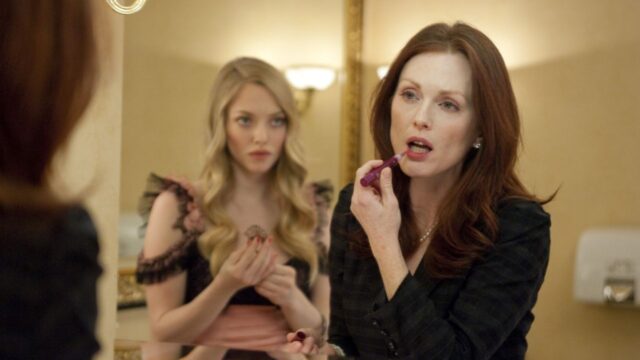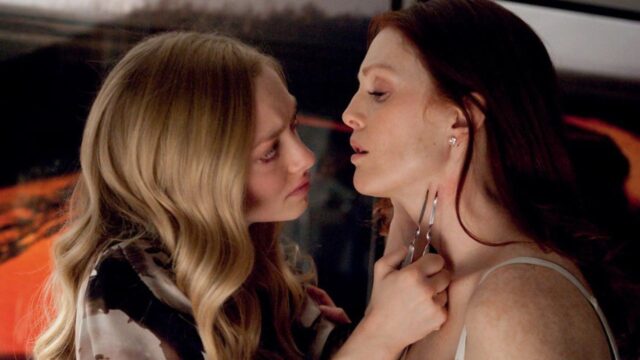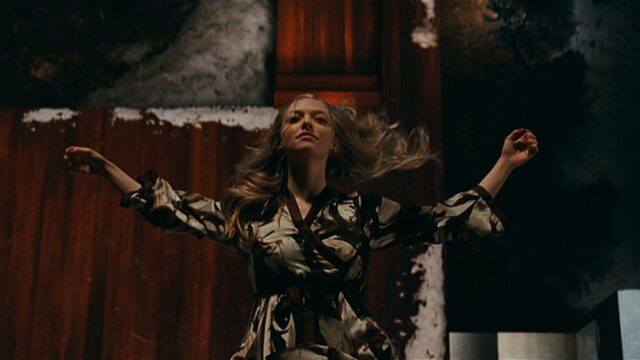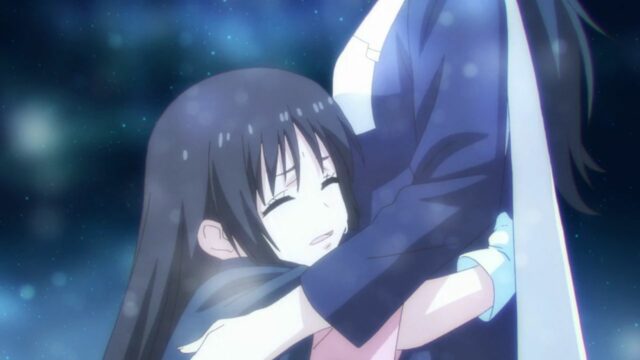With “Exotica,” a 1994 film by Canadian filmmaker Atom Egoyan that explores sex, money, and loneliness among the employees and customers of a posh Toronto strip club, the director burst onto the global indie scene. Fifteen years later, the filmmaker returned to the same setting, but from a new perspective, with the sensual thriller “Chloe.”
Here, Amanda Seyfried, the eponymous sex worker, operates out of a posh hotel lobby rather than a seedy club, and her clientele consists of one guy at a time—or, in this case, one woman—rather than a room full of rich but pitiful men. Julia Moore plays Catherine, a middle-aged physician who feels unnoticed by her husband David (Liam Neeson) and teenage son Max (Max Thieriot).
Chloe Movie Plot Summary: What Key Details Should You Remember?

Catherine Stewart, a successful gynecologist in Toronto, navigates a life as structured and cold as her ultramodern suburban home. Despite her professional accomplishments, her personal life turns when she discovers a compromising photo on her husband David’s phone after his New York business trip.
David, a charismatic university professor known for his flirtatious nature, becomes the subject of Catherine’s suspicions. Instead of confronting him, Catherine hires Chloe, an escort from a luxury hotel near her office, to test David’s fidelity.
Chloe’s reports of encounters with David draw Catherine into a whirlwind of emotions. Torn between disbelief and intrigue, Catherine uses Chloe as a sexual surrogate, delving into an obsessive exploration of her marriage. At their son Max’s piano recital, Catherine’s paranoia intensifies when she sees David touch another woman. Desperate, she seeks out Chloe, leading to a dramatic and intimate confrontation in Chloe’s hotel room.
Chloe Movie Ending Explained: What Happens at the Climactic Finale?

In the shocking climax of Chloe, the lines between obsession and reality blur, leading to devastating consequences. After Chloe becomes infatuated with Catherine following their night of passion, her presence becomes intrusive—she shows up at Catherine’s office and flirts with her son, Max.
Meanwhile, David begins suspecting Catherine of having an affair. Seeking clarity, Catherine arranges a meeting with Chloe and David, only to discover that Chloe’s detailed accounts of an affair with David were fabricated. While this revelation allows Catherine and David to reconnect emotionally and physically, Chloe’s obsession turns dark.
Unbeknownst to Catherine, Chloe seduces Max while she and David reconcile. Catherine returns home to find them asleep together, prompting a confrontation that escalates violently. Chloe attacks Catherine with a silver hairpin—their initial symbol of connection. During the struggle, a window breaks, and Chloe tragically falls to her death on the shattered glass.
Months later, the Stewarts host a graduation party for Max, presenting a picture of unity. Yet, a haunting reminder of Chloe lingers—Catherine is seen wearing Chloe’s silver hairpin, symbolizing the enduring impact of the events that unraveled their lives.
Was Chloe’s Death in the Movie an Accident or Intentional?

In the pivotal moments of Chloe, a life-or-death struggle between Catherine and Chloe unfolds. As Chloe attacks Catherine with the hairpin, drawing blood, she kisses her in a moment charged with emotion.
Catherine, noticing Max watching through the reflection in the window, pushes Chloe away, inadvertently causing the window to pop out of its frame. Chloe clings to the edge briefly before slipping and falling to her death. Catherine’s immediate panic reveals her innocence—this was not an act of murder.
Chloe’s mindset, however, remains ambiguous. While she couldn’t have planned this precise outcome, her serene expression during the slow-motion fall suggests it might have been a deliberate act—a way to cement herself in Catherine’s life permanently. On the other hand, the physical details, like her gripping the frame and the questionable lethality of a second-story fall, hint at an accident.
Though the theatrical cut opens the moment to interpretation, alternate endings suggest a clearer resolution. Regardless of intent, Chloe’s death leaves an indelible mark on Catherine and her family, making this moment one of the film’s most haunting and memorable twists.
Chloe Movie Alternate Endings: Shocking Differences and What They Reveal

In Chloe, the question of whether Chloe’s fall was an accident or a deliberate act becomes clearer in the film’s alternate endings. In one version, Chloe’s voiceover after her death reveals that she intentionally let go of the window frame to ensure she would always be a part of Catherine’s life.
This dramatic, obsession-fueled self-sacrifice aligns with the final shot of the hairpin, underscoring her obsessive attachment to Catherine, though it can feel extreme and uneven. The other alternate ending offers a much bleaker perspective, with Catherine’s voiceover reflecting on Chloe’s death as a “second chance” at life.
This ending, while dark, comes across as insensitive, framing Catherine’s self-centered privilege as she reframes Chloe’s tragic demise as a personal opportunity. Both endings provide a stark contrast in tone, leaving viewers with an unsettling conclusion.
What the Ending of Chloe Really Means: The Dark Reclamation of Power and Control
The ambiguous ending of Chloe leaves a lasting impact, with the final shot of Catherine wearing Chloe’s hairpin symbolizing a chilling reclamation of control.
Director Atom Egoyan’s erotic thriller expertly highlights the unsavory nature of Chloe’s death, which is brushed aside in Catherine’s cold, calculated quest for autonomy. By wearing the hairpin, Catherine reasserts her dominance over the situation, using it as a token of her power and the cost of a woman’s life—one often marginalized in society.
Egoyan has discussed how Catherine’s obsessive need for control makes her the story’s villain. While her actions are a product of societal pressures, she remains emotionally distant and callously downplays the consequences of her choices.
Chloe, in contrast, is a symbol of fleeting desire and violence, existing solely as a vessel for Catherine’s emotional and sexual needs, only to disappear—remembered forever through the hairpin that now binds the two women’s fates together.
About Chloe
Chloe is a 2009 erotic thriller film directed by Atom Egoyan, a remake of the 2003 French film Nathalie…. It stars Julianne Moore, Liam Neeson, and Amanda Seyfried in the title role. Its screenplay was written by Erin Cressida Wilson, based on the earlier French film, written by Anne Fontaine.
Despite receiving mixed reviews from critics,the film was a commercial success and it grossed more at the worldwide box office than any of Egoyan’s previous films.








No Comments on Chloe Movie Ending Explained: What Happens at the End of Chloe?